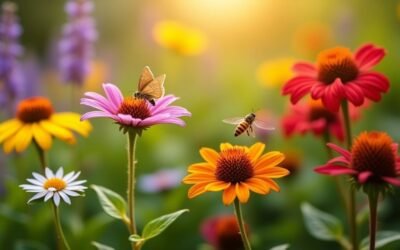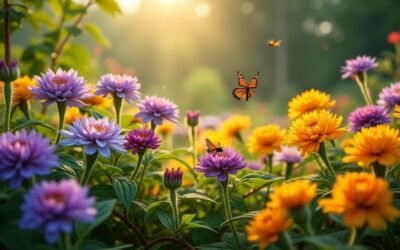Stachys byzantina, commonly known as Lamb's Ear, is a enchanting herbaceous perennial celebrated for its soft, velvety leaves and distinctive cottony flower spikes. This plant typically reaches heights of 6-12 inches, with flower spikes elevating up to 18 inches, and spreads widely, making it an excellent ground cover. Thriving in full sun or partial shade, Lamb's Ear flourishes in well-drained soils, showcasing impressive drought resistance once established. With its nectar-rich purplish-pink flowers, this species attracts various pollinators, enhancing garden biodiversity. Understanding its care and common challenges can lead to a thriving garden that remains visually striking throughout the seasons.
Main Points
- Stachys byzantina, commonly known as Lamb's Ear, features soft, velvety leaves and produces small purplish-pink flowers in late spring to summer.
- This herbaceous perennial thrives in full sun to partial shade and prefers well-drained, moderately fertile soils.
- It is drought tolerant once established but requires consistent moisture during the initial growth phase.
- Lamb's Ear attracts pollinators, such as bees and butterflies, with its nectar-rich flowers while deterring browsing herbivores with fuzzy leaves.
- Common issues include slugs and root rot; ensure excellent drainage and monitor soil moisture for healthy growth.
Introduction
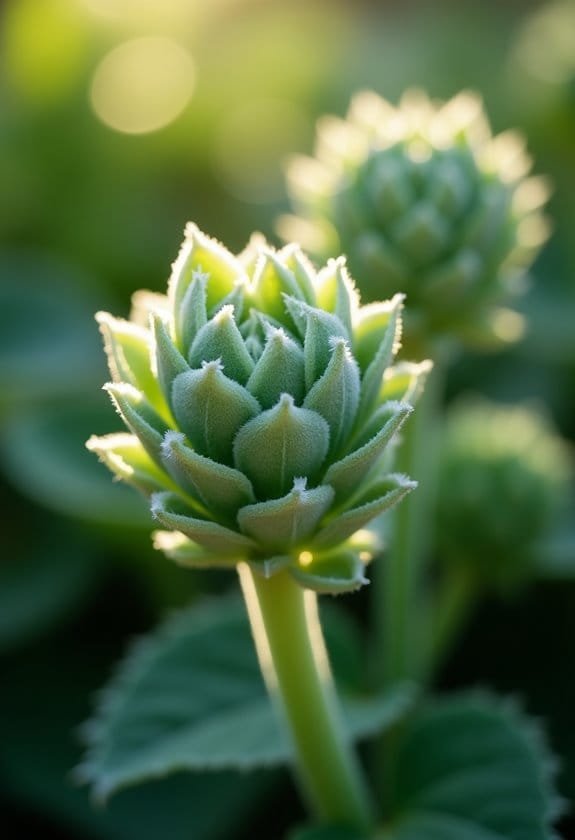
Stachys byzantina, commonly referred to as Lambs Ear, embodies the charm of the Middle East with its striking silver-gray foliage.
This perennial plant not only enchants with its soft, velvety leaves that mimic a lamb's ear but also impresses with its capability to flourish in varying soil types and conditions.
Understanding its botanical characteristics, ornamental appeal, and resilience reveals why Lambs Ear has become a beloved choice in many gardens.
Common Name
The charm of Lambs Ear, a popular common name for Stachys byzantina, lies in its soft, velvety leaves that evoke the image of a lamb's ears, making it a favored choice for ornamental gardens.
This plant is also known as Donkeys Ears, Wooly Betony, and Lambs Wool, all names inspired by its unique leaf shape and texture. The delicate foliage not only adds visual appeal but also invites touch, encouraging interaction with the natural world.
Lambs Ear's cottony flower spikes have led to another affectionate designation—Cotton Boll Lambs Ear—highlighting the plant's multifaceted character.
Historically, Stachys byzantina has been classified under several names such as Stachys lanata and Stachys olympica, which underscores its complex botanical lineage.
Furthermore, the genus name "Stachys" derives from Greek, meaning "ear of corn," while the specific epithet "byzantina" pays homage to the classical Byzantine era, reflecting the plant's deep-rooted connections to history and culture.
With its enchanting aesthetics and diverse nomenclature, Lambs Ear isn't just a plant; it's a botanical narrative that enchants gardeners and plant lovers alike.
Scientific Name
Known scientifically as Stachys byzantina, this enchanting plant belongs to the Lamiaceae family, often referred to as the mint family. The genus name "Stachys" derives from the Greek word for "ear of corn," aptly reflecting the distinctive shape of the plant's leaves. With its thick, fuzzy, silver-green foliage, Stachys byzantina creates a striking visual feature in any garden space.
The epithet "byzantina" points to the historical richness and origins tied to the classical Byzantine era, indicating the plant's enduring significance over time. Before finally settling on its accepted designation, Stachys byzantina was classified under several names, including Stachys lanata and Stachys olympica, showcasing a journey of scientific exploration and refinement.
This herbaceous perennial not only enthralls with its unique leaf structure but also showcases small, purplish-pink flowers, which bloom on tall spikes during late spring or summer.
These characteristics illustrate the plant's adaptive beauty, inviting gardeners and botanists alike to appreciate the delightful nuances inherent in the Stachys byzantina. Ultimately, this enthralling member of the mint family enhances landscapes while enriching our understanding of botanical history.
Overview
Lamb's Ear, a striking perennial more formally identified as Stachys byzantina, captures the interest of gardeners and plant enthusiasts alike with its soft, velvety leaves and charming flowers. Native to the Middle East, this perennial plant showcases silvery-gray foliage that resembles this affectionately named herb's ears.
Typically, Lambs Ears spread into low, sprawling clumps, achieving heights of 6-8 inches in foliage, and 12-18 inches when adorned with delicate pink to purple flowers in late spring or early summer.
Remarkably adaptable, Lamb's Ear thrives in various soil types, preferring moderately fertile, well-drained conditions, and exhibiting impressive drought tolerance once well-established. The lush woolly leaves not only provide aesthetic appeal throughout the growing season but also considerably minimize water loss, a critical trait for resilience in drier climates.
Stachys byzantina is hardy across USDA zones 4-8, demonstrating resilience against pests, deer, and rabbits, making this perennial a reliable, low-maintenance choice for landscaping and ground cover.
Given its year-round ornamental value and hardiness, Lamb's Ear is an exceptional addition to any garden, seamlessly blending beauty with functionality.
Key Features
Stachys byzantina, commonly known as Lamb's Ear, showcases distinctive characteristics that make it an appealing choice for gardeners.
With soft, velvety silvery-gray leaves reaching 6-8 inches in height, it adds a unique texture, while its flower spikes, extending up to 18 inches, bloom with charming pink to purple flowers in late spring.
This perennial not only offers visual interest throughout the growing season but also thrives in a variety of conditions, solidifying its place in diverse landscapes.
Growth Size
One will often find that Stachys byzantina grows to a height of 6-12 inches (15-30 cm), with its flower spikes reaching up to 12-18 inches (30-45 cm) tall. This perennial forms low, sprawling clumps, effectively spreading 12-36 inches (30-90 cm) wide, making it an excellent ground cover for various garden settings.
The growth size is particularly remarkable, as it allows this plant to create a lush and textured appearance in the landscape.
The leaves, measuring several inches long and exhibiting an oval shape, contribute greatly to Stachys byzantina's charm. Cloaked in a velvety texture and donned in a striking silver-gray hue due to fine silvery hairs, the foliage not only fascinates the eye but also adds a tactile element to garden beds.
In warmer climates, the plant showcases evergreen characteristics, holding its enchanting leaves throughout the year. However, during harsher winters, it may die back before rejuvenating come spring.
Varieties such as "Big Ears" flaunt larger leaves, while the "Silver Carpet" stays shorter, at just 4-6 inches (10-15 cm), enriching the diversity of growth habits within this delightful species.
Appearance
With its thick, soft, velvety leaves, Stachys byzantina captivates gardeners and passersby alike. Commonly referred to as Lamb's Ear, this perennial plant features stunning oval-shaped leaves that can reach lengths of several inches, embodying a striking silver-gray or woolly-white hue reminiscent of the ears of young lambs. Densely covered in fine silvery hairs, the hairy leaves contribute to the plant's unique, tactile texture, inviting a gentle touch.
Typically reaching heights of 6–8 inches (15–20 cm), Lamb's Ear flourishes low to the ground, creating a lush, spreading carpet of foliage. During the late spring or early summer, flower spikes emerge, soaring to heights of 12–18 inches (30–45 cm) above the verdant base. These spikes bear small, delicate flowers, ranging from pink to purple, which rise above the foliage, adding an alluring visual contrast.
The charming leaves not only provide year-round interest through their evergreen persistence in milder climates but also serve as a stunning backdrop to the plant's floral display.
Stachys byzantina is, thus, an attractive choice for gardens seeking both texture and visual appeal throughout the growing season.
Flowering Season
The flowering season of Stachys byzantina, or Lamb's Ear, typically occurs from late spring to early summer. During this period, the plant produces delicate flower stalks adorned with small pink to purple blossoms. Rising gracefully from the low-growing, silvery-gray foliage, these flower spikes can reach an impressive height of 12 to 18 inches, creating a striking visual contrast in any garden.
Each flower spike features clusters of tiny flowers elegantly arranged, often partially concealed by lush calyces, enhancing the plant's ornamental appeal. Although the primary charm of Lamb's Ear lies in its silvery foliage, the blooming phase in the second year of growth adds a delightful dynamic. The appearance of the flowers enriches the landscape, inviting pollinators and drawing the eye.
To maintain a pristine garden aesthetic, gardeners should practice deadheading spent flower stalks after blooming. This not only promotes a tidy appearance but also encourages fresh growth for the following season.
To conclude, the flowering season of Stachys byzantina not only showcases the plant's unique beauty but also enriches the overall garden experience, making it a cherished selection for many horticulturists.
Growing Requirements
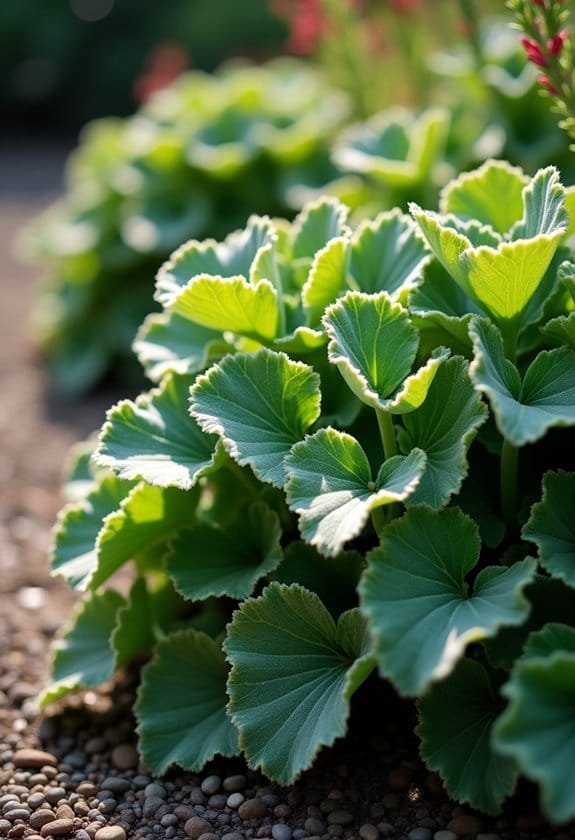
When it comes to the growing requirements of Stachys byzantina, this resilient plant displays specific preferences in light, soil, and water conditions.
Thriving in full sun to partial shade, it flourishes with abundant light, enhancing its lush green foliage.
Moderately fertile, well-drained soils, ideally with a slightly acidic pH, support its root development.
Once established, Lambs Ear demonstrates impressive drought tolerance, necessitating regular watering only during its initial growth phase.
This emphasizes the importance of balance in moisture to prevent root-related issues.
Light
Lamb's Ear (Stachys byzantina) flourishes in full sun, where its foliage becomes denser and healthier. Ideally, these plants should receive a minimum of six hours of direct sunlight daily to guarantee robust growth and flowering potential.
The vibrant silver-gray foliage, which is characteristic of Lamb's Ear, thrives under ideal lighting conditions, highlighting its lush texture and appealing aesthetic. Similar to Primula vulgaris(Primula vulgaris), Lamb's Ear also benefits from capabilities that promote plant health when properly positioned in bright sunlight.
In regions experiencing intense summer heat, it's wise to provide partial shade during the hottest parts of the day, helping to shield the plant from undue stress. This protective measure prevents the leaf burn that can occur when plants are exposed to excessive sunlight for prolonged periods.
While Lamb's Ear can tolerate light shade, it's important to acknowledge that full sun exposure is essential for achieving the vigorous health and beauty associated with this species. Additionally, the plant benefits from growing in well-drained soils, resembling the growing requirements of other plants like crab apple trees.
Ultimately, the delicate balance of sunlight fosters an engaging habitat where Lamb's Ear can truly shine, contributing its unique charm to gardens and landscapes alike.
Gardeners should aim for bright, sunny locations when planting, guaranteeing these resilient perennials receive the light they crave for maximum growth.
Soil
For ideal growth, Stachys byzantina thrives in moderately fertile, well-drained soil that maintains a slightly acidic to neutral pH. This resilient plant exhibits a remarkable tolerance for various soil types, including sandy, loamy, and clay soils.
However, it's essential to guarantee adequate drainage, as compacted or heavy, overly moist soils can lead to detrimental conditions such as crown rot. Good air circulation around the roots is fundamental for healthy development, as it reduces the risk of disease associated with excessive moisture.
Although Stachys byzantina demonstrates drought tolerance once established, it requires consistent moisture during its initial growth phase, emphasizing the need for cautious watering practices. Overwatering can considerably hinder growth, leading to root rot and potential plant decline.
To improve nutrient availability without necessitating fertilization, gardeners can incorporate organic materials like compost into the soil before planting. Doing so enriches the growing medium, thereby fostering better nutrient uptake and promoting vigorous growth. Additionally, incorporating Creeping Cinquefoil's ecological benefits can enhance the overall health of the planting area.
Adopting these soil recommendations won't only support the plant's development but also enhance its aesthetic appeal in any garden setting.
Water
Achieving ideal growth for Stachys byzantina involves a careful balance of water management. This striking plant requires approximately 1 inch of water weekly, specifically during its establishment phase. Providing consistent moisture in these early stages is essential to prevent stress, guaranteeing vigorous development.
However, once established, Lamb's Ear demonstrates remarkable drought tolerance, a proof of its adaptive nature. It's important to avoid overwatering, as excessive moisture can lead to root rot and various fungal diseases; therefore, well-drained soils are indispensable for its thriving. The species can thrive in soils similar to those preferred by Long-headed poppy(Papaver dubium), which also benefits from well-drained conditions.
Lamb's Ear flourishes in average conditions, thriving best in environments characterized by dry to medium moisture levels. Consequently, gardeners should carefully monitor soil conditions, making certain it doesn't become waterlogged, which could jeopardize the plant's health.
Additionally, providing afternoon shade during scorching summer days can be beneficial, helping maintain ideal soil moisture and preventing excessive water loss due to evaporation. Ajuga reptans, noted for its ground cover capabilities, can serve as a companion plant to help control weeds while Lamb's Ear establishes its root system.
Temperature
The ideal temperature range for Stachys byzantina, or Lamb's Ear, is crucial for its growth and overall health. Thriving in USDA hardiness zones 4 to 8, this resilient perennial flourishes in a variety of temperate climates.
For maximum growth, Lamb's Ear prefers full sun exposure, although it benefits from slightly reduced light during intensely hot periods to mitigate the risk of leaf scorch.
Temperature directly influences the plant's vitality; extreme humidity can be detrimental, fostering conditions that lead to root rot and fungal diseases, particularly in poorly draining soils.
During colder months, the plant typically dies back, preparing itself for rejuvenation in spring as the temperature warms. This seasonal dormancy is a remarkable adaptation that underscores its hardiness.
Furthermore, established Lamb's Ear exhibits moderate drought tolerance, enabling it to withstand low-water conditions without succumbing to stress.
Such resilience, however, is best preserved when optimal temperature management and humidity control are prioritized. Additionally, Lamb's Ear benefits from thriving in moist environments, as seen in plants like Brooklime which require consistent water for growth.
Therefore, understanding and providing the right environmental conditions guarantees Lamb's Ear remains a lush, healthy addition to any garden.
Pollinator Criteria
Stachys byzantina attracts a select group of pollinators, primarily bees and butterflies, thanks to its vibrant pink to purple flowers that bloom from late spring to early summer. However, the plant's modified and somewhat sterile flowers limit its ability to produce seeds, which can impact long-term support for these pollinator populations. Understanding how these interactions unfold in the garden's ecosystem is essential, as it highlights the delicate balance between ornamental beauty and ecological responsibility. Additionally, promoting beneficial pollinators can enhance garden biodiversity and improve overall plant health. The presence of flowering plants, such as Blue Fleabane, plays a crucial role in attracting a variety of pollinators, contributing to the overall ecological balance.
Attracted Pollinators
Typically, Stachys byzantina, commonly known as Lamb's Ear, attracts a variety of pollinators with its small pink to purple flowers that bloom in late spring to early summer.
These flowers, which are arranged on tall spikes reaching heights of 12-18 inches, serve as visible targets for bees and butterflies seeking nectar sources. Although Lamb's Ear isn't classified as a significant wildlife attractor, its blooms provide vital nourishment for various pollinators during the flowering season.
Interestingly, the plant's fuzzy, woolly leaves deter browsing herbivores such as deer and rabbits, allowing pollinators easier access to the flowers without significant competition. This great adaptation strengthens its ability to thrive in diverse gardens, similar to how wood sage (Teucrium scorodonia) attracts bees and wasps with its nectar-rich flowers.
This greatly benefits the ecosystem by enhancing the survival rate of pollinators, which play an essential role in plant reproduction. Furthermore, regular deadheading of spent flowers encourages additional blooms throughout the growing season, maximizing nectar availability.
In this way, Lamb's Ear not only bolsters its floral display but also nurtures an environment where pollinators thrive, reinforcing the interdependence of plant and pollinator dynamics within gardens and natural habitats alike.
Additionally, its ability to attract various pollinators highlights the importance of biodiversity within ecosystems, demonstrating how different plant species work in harmony to support local wildlife.
This interaction exemplifies the intricate balance within ecosystems that sustain both flora and fauna.
Pollination Method
Lamb's Ear's pollination method effectively engages various insects, with its nectar-rich flowers serving as a beacon for bees and butterflies. Typically, the small pink to purple flowers bloom in late spring to early summer, coinciding with the active periods of these crucial pollinators.
Flowering spikes can reach heights of 12 to 18 inches, making them easily visible and accessible for insects seeking nourishment. The nectar produced is essential for the sustenance of bees and butterflies, providing them with the energy needed to thrive. As they forage, these pollinators transfer pollen from flower to flower, facilitating reproduction in the plant.
While primarily adapted for attracting bees and butterflies, Lamb's Ear flowers don't serve as a significant pollination source for agricultural crops but excel in ornamental gardens. Moreover, the fuzzy, silvery foliage, which adds aesthetic appeal, acts as a natural deterrent to certain herbivorous pests. This protective quality allows pollinators to forage more freely, ensuring the plant can flourish amidst potential threats. Additionally, the extended blooming season of Lamb's Ear complements local biodiversity, supporting the health of pollinator populations.
Care & Maintenance
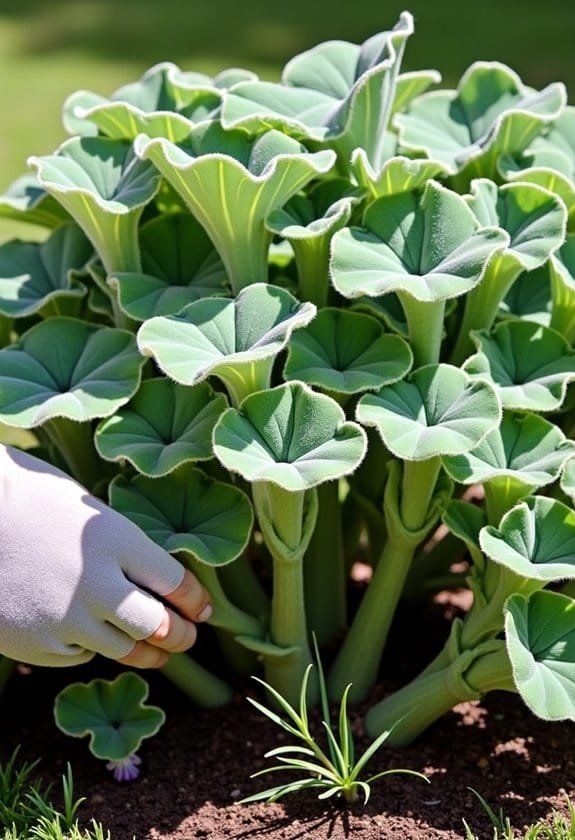
Caring for Stachys byzantina requires attention to its specific needs for ideal growth and maintenance.
To start, understanding the planting conditions—full sun to partial shade and well-drained, moderately fertile soil—will guarantee robust establishment.
Ongoing care involves consistent watering until the plant is established, judicious pruning after flowering, and thoughtful consideration of companion plants to enhance the garden's ecosystem.
Planting Tips
To guarantee thriving conditions for Stachys byzantina, gardeners should focus on providing ample sunlight and well-drained soil. This herbaceous perennial flourishes best in full sun, though it can tolerate partial shade, ensuring a vibrant and dense foliage.
Choosing the right location is essential; the plant thrives in well-drained soils, whether sandy, loamy, or even clay—though the latter should be worked to enhance drainage.
When planting, it's important to establish a routine watering schedule until the plant is settled, as the young Lamb's Ear benefits from consistent moisture. Once established, it exhibits remarkable drought tolerance, allowing gardeners to reduce irrigation frequency.
In addition, to maintain the plant's vigor, it's advisable to divide clumps every two to three years, especially for those varieties that produce abundant flowers.
Gardeners should also consider aesthetics; deadheading spent flower stalks post-bloom promotes a tidy appearance and encourages additional growth.
Regularly monitoring the area for slugs and snails is wise, as these pests can hinder development.
Finally, ensuring good air circulation around the plant minimizes the risk of root rot or fungal diseases, particularly in overly moist conditions, thereby safeguarding the plant's overall health and prosperity.
Ongoing Care
Maintaining Stachys byzantina involves regular attention to pruning and monitoring for pests. To guarantee ongoing care, one should prune spent flower stalks promptly after blooming. This practice not only preserves the plant's tidy appearance but also encourages robust new growth.
Every two to three years, it's advisable to divide the plants, preventing overcrowding—crucial for flowering varieties that thrive under ideal space conditions.
While Lamb's Ear demonstrates exceptional drought tolerance once established, it requires consistent watering during the initial growth phase, particularly in well-drained soil. A keen gardener will monitor plants for slugs and snails; these pests, while not a significant threat compared to others, can still cause unexpected damage on occasion.
Cutting back dead foliage to soil level in late fall or early spring is critical, as it supports vigorous regrowth and minimizes disease risks during the winter dormancy period.
Through diligent care practices, such as timely pruning, vigilant pest monitoring, and thoughtful division, Stachys byzantina can flourish, exhibiting the lush, silvery foliage and vibrant blooms that capture many gardeners' hearts. These steps guarantee the longevity and health of this charming perennial.
Suggested Companions
In any vibrant garden, selecting the right companions for Stachys byzantina can enhance both aesthetic appeal and ecological balance. Lamb's Ear thrives alongside flowering perennials like daylilies and coneflowers, which offer vibrant colors and contrasting textures that captivate the eye.
To guarantee harmony in growth, all companion plants should share similar requirements for full sun and well-drained soils; this compatibility fosters a thriving ecosystem. Moreover, the drought-tolerant nature of Lamb's Ear allows it to flourish beside other drought-resistant species, such as succulents, effectively minimizing water needs across the garden. This adaptability makes it an excellent choice for gardens with challenging garden environments, ensuring that diverse plant species can thrive together.
Positioning Lamb's Ear as a lush ground cover in the front of the garden bed creates a dynamic display, accentuating taller companions like phlox and delphiniums at the rear, which can reach heights of up to three feet.
Additionally, the fuzzy leaves of Lamb's Ear serve a dual purpose: not only do they contribute to the garden's beauty, but they also deter pests like deer and rabbits. This resilient nature helps it coexist with plants that may otherwise struggle, such as those impacted by aggressive growth of invasive species in their environment.
Therefore, Stachys byzantina emerges as a valuable ally in sustainable gardening, promoting both visual harmony and natural pest resistance while creating a flourishing sanctuary.
Common Issues
Stachys byzantina, while generally resilient, faces challenges from pests and environmental factors that demand attention.
Slugs and snails can occasionally compromise its lush foliage, and overly moist soils may lead to root rot, highlighting the importance of well-drained conditions and good air circulation.
Awareness and proactive management, such as proper soil choices and regular division, can greatly enhance the plant's ability to thrive and flourish in diverse settings. Additionally, understanding the plant's ecological role is crucial for promoting its health within the garden ecosystem.
Pests/Diseases
While Lamb's Ear is known for its resilience against pests, gardeners should still keep an eye out for potential issues. This hardy plant boasts hairy leaves that typically deter many common garden insects. However, slugs and snails occasionally find their way to the soft foliage, posing a threat. These pests may feast upon the leaves, leading to unsightly damage, so vigilance remains necessary for maintaining plant health.
In addition to pest concerns, Lamb's Ear is susceptible to fungal diseases, particularly in environments characterized by high humidity or poorly draining soils. Overly moist conditions foster an environment ripe for leaf rot and root decay, potentially resulting in the death of central growth as new roots struggle to develop.
It's essential for gardeners to guarantee that the soil drains adequately, promoting healthy root systems. To prevent the onset of fungal infections, proper air circulation is crucial.
Regular sanitation practices, such as removing infected leaves, not only curb disease dissemination but also enhance overall plant vigor. By employing these precautions, gardeners can effectively bolster the resilience of their Lamb's Ear against both pests and fungal threats.
Solutions
Managing the health of Lamb's Ear involves addressing common issues that can arise during its growth. To promote ideal health, it's essential to plant Stachys byzantina in well-drained soils. This practice prevents root rot, a condition caused by overly moist environments, which often leads to detrimental fungal diseases.
Alongside this, gardeners should avoid overwatering; maintaining balanced moisture levels guarantees the plant thrives without succumbing to excessive dampness.
Regular maintenance also includes monitoring for slugs and snails that might be drawn to Lamb's Ear. By implementing natural pest control methods, such as introducing beneficial insects, one can effectively safeguard the plant's vigor. Additionally, ensuring that the plants receive consistent moisture as noted in their growing requirements can enhance resilience against pests.
Furthermore, thinned and divided clumps every 2-3 years foster robust growth, as overcrowding can result in unsightly dead centers.
After blooming, deadheading spent flower stalks enhances neatness and may even extend blooming periods for new spikes, allowing gardeners to enjoy longer displays of this lovely perennial.
In addition, in conditions characterized by humidity or excessive rainfall, increasing air circulation around the plants mitigates the risk of leaf rot and other fungal infections, thereby safeguarding their health and aesthetic appeal. Moreover, consistent care such as maintaining adequate soil moisture through regular watering is key to their success.
Summary
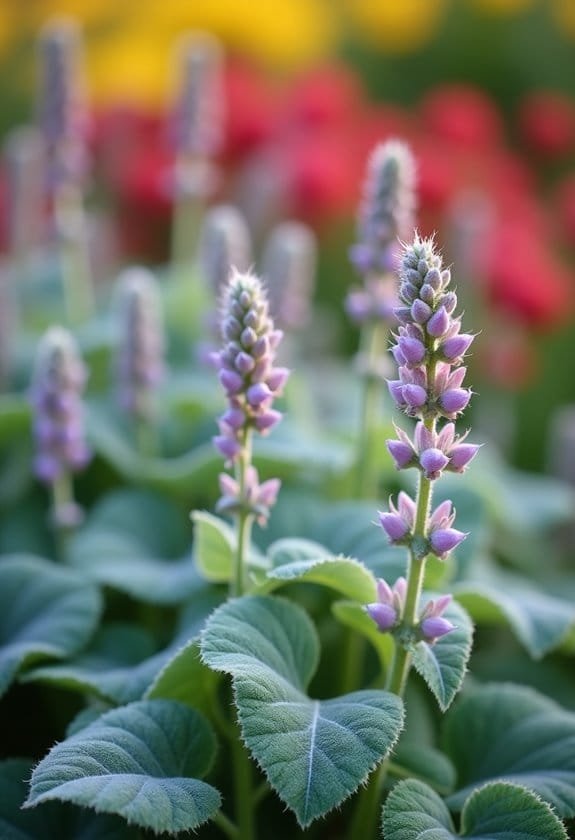
Lamb's Ear, scientifically known as Stachys byzantina, is a fascinating perennial recognized for its thick, velvety, silvery-green leaves. Reaching heights of up to 8 inches, this plant forms an attractive ground cover, exuding a soft texture reminiscent of a lamb's ear, while its flower spikes can ascend to 12-18 inches during blooming season.
Thriving in full sun to partial shade, Stachys byzantina prefers moderately fertile, well-drained soil, making it particularly suited for USDA hardiness zones 4-8.
Once established, this resilient perennial exhibits excellent drought tolerance, requiring minimal maintenance. A gentle approach, such as occasional deadheading, can enhance its appearance and promote additional blooms. While Stachys byzantina's small pink to purple flowers grace gardens in late spring and early summer, its primary allure emerges from its lush foliage.
Notably, Lamb's Ear is generally pest-resistant and deer-resistant due to its fuzzy leaves, positioning it as an ideal choice for low-maintenance landscapes.
The combined qualities of aesthetic appeal, hardiness, and ease of care make Stachys byzantina a valued addition to any garden, inviting admiration while demanding little in return.

